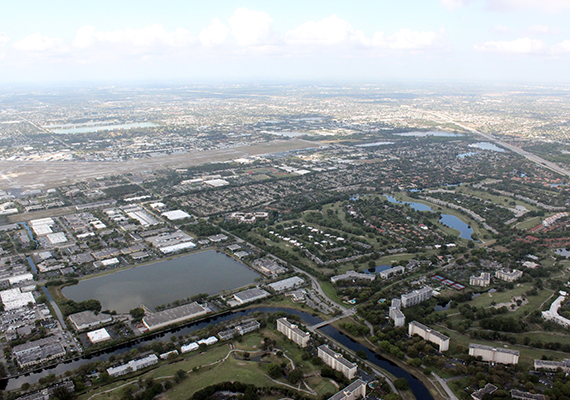Trending
Why multifamily players are betting on suburbs, not cities, in South Florida

You might pass them during your morning commute on I-95: big, sprawling apartment complexes with names such as Luzano that sound more like they belong on the Italian Riviera rather than a plot of land in Pompano Beach.
But while they may be the furthest thing from a glimmering high-rise in downtown Miami, many of South Florida’s developers and investors see something past the dog parks and barbecue pits: stability.
“At the end of the day, apartments always offer a basic need: shelter,” Joe Thomas of Marcus & Millichap told The Real Deal.
The proof is in the numbers: since the beginning of this year, data from the CoStar Group shows investors and developers have traded a little over $4 billion worth of multifamily properties in South Florida alone, and most of those deals were struck in suburban parts of Fort Lauderdale, West Palm Beach and Miami.

Greg Ward
“Right now it’s a tale of two different markets,” Greg Ward, the managing director of the Atlantic | Pacific Real Estate Group told TRD. Apartments in dense urban cores like downtown Miami are fetching rents of $2 per square foot and up, he said, while communities in more suburban areas are in the $1.50 per square foot range.
Ward’s company just finished a $120 million round of fundraising with its partner Blue Arch Advisors to buy multifamily properties in the Southeastern and Southwestern U.S. The plan, the partners said at the time, is to look for properties in affluent suburbs near major cities that can be bought, managed by Atlantic | Pacific and renovated to increase their value.
It’s a common tactic among investment companies. South Florida has an abundance of apartment properties that were built in the 1990s and early 2000s that just need a fresh coat of paint, updated interiors and new management to bring their rents up to market rate.
The map below includes South Florida multifamily sales above $500,000 and five units per property since the beginning of 2016. Click on each dot for an address and price.
But there are much larger differences in those two markets than just rents. Ward said there are “significant” oversupply issues in many core markets — a problem not often shared by suburban areas, where supply is more regulated because rents don’t necessarily support ground-up development.
The latest numbers from Marcus & Millichap show 6,740 new apartment units are set to open in Miami-Dade County by the end of this year, the largest annual influx of new inventory in the last 17 years. Much of that new construction is in the Greater Downtown Miami area — 4,776 units, according to an April report from the Downtown Development Authority.
With all those new units coming out of the ground, suburban markets can offer an attractive alternative to investors who don’t want cutthroat competition for properties trading at premiums. They can also be appealing for developers who aren’t interested in the risks of building a luxury high-rise, which is practically mandated in downtown areas because of land constraints.

Nicole Shiman
“Multifamily developers in many cases have been priced out [of downtown areas] where they can no longer afford to build and no longer want to take on the risk to build,” Nicole Shiman, vice president of Miami-based 13th Floor Investments told TRD. “They’re finding more opportunity in the suburban markets where you still have green space; [there are] not as many barriers to entry.”
Even in down markets, rental communities have the advantage over other commercial properties. Apartments “kick out very strong cash flow,” Shiman said. So while property prices might not favor selling off a community for months or maybe even years, she said “It’s an asset you can pass from generation to generation.”
Meanwhile, there’s a subtle shift going on in South Florida’s demographics, according to Shiman. In past decades, she said, the cultural norm in America was to get married, have a child and buy a home. But recent years have seen a slew of would-be homebuyers searching instead for walkable neighborhoods, or to move between neighborhoods and cities every few years.
“All of these trends really lend themselves to a rental lifestyle,” she said. But before, those ideals didn’t fit with suburbia. Not until now, at least.
Recent boosts in transit-oriented development have also helped connect neighborhoods like South Miami to urban cores, helping dissolve the stigma of living far from where the action is happening.
Shiman said 13th Floor is on the eve of breaking ground on its Motion at Dadeland project, a high-rise apartment building 294 units that’s within walking distance to Dadeland’s Metrorail station. From there, it’s a relatively quick 15-minute train ride to Brickell.
“We really like to be in areas we deem as sort of high traffic count, not necessarily main and main in the most desirable locations,” Shiman said. “Despite the fact that [Dadeland] has historically been considered South Miami…it’s an area we’ve been really excited about in a multifamily perspective because of its proximity to the metro line.”
New mass transit options like All Aboard Florida’s Brightline commuter service are also drawing in developments to once-passed-over neighborhoods, she said.
In Flagler Village, an up-and-coming area in Fort Lauderdale that some are hoping will mirror the success of Miami’s Wynwood, both institutional developers and newcomers are transforming what was once a single-family neighborhood into a millennial hot spot.

Joe Thomas
Related Group quickly finished and sold its Manor at Flagler Village, a 382-unit development, for nearly $150 million in July 2015 to academic pension manager TIAA.
The skys aren’t all clear for the multifamily market, however. Because of the uncertainty sewn by Britain’s upcoming exit from the European Union, as well as financial and social chaos in some Latin American countries, Marcus & Millichap’s Joe Thomas said real estate players are going to keep a close eye on the market for the next few months.
Even without those foreign factors, change could be coming to South Florida.
“Rents have moved quite a bit, typically those are triggers for some normalization of the market in the not-too-distant future,” Thomas told TRD. “But most of what has been built recently has been leased up with strong rates. South Florida is still one of the most attractive major markets in the country as far as prices and valuation.”
TRD Researcher Eda Kouch contributed to this report.




